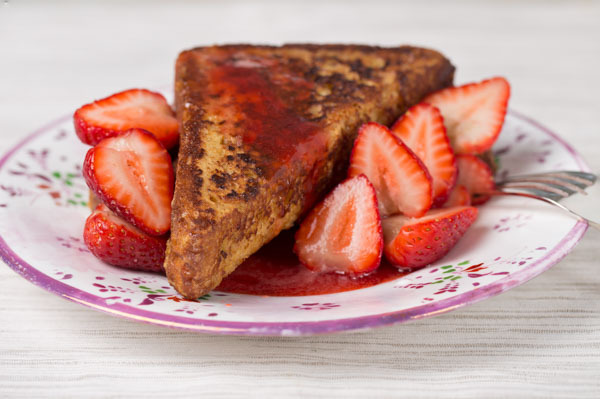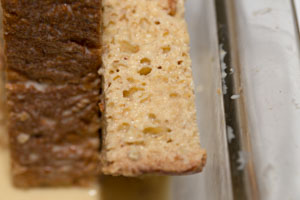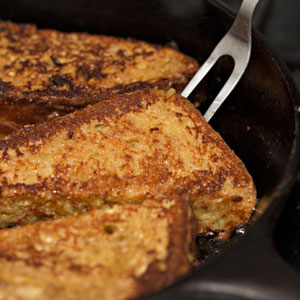Brioche French Toast

introduction
This isn’t the kind of French toast Dustin Hoffman whips up in Kramer vs. Kramer, or the kind I used to fork at a coffee shop on Second Avenue to smooth a hangover. Those types are emergency French toast: soft sliced bread dunked in a whole egg conditioner and slapped, dripping, onto a Teflon pan or flat griddle. Emergency French toast can be summoned on the fly. Our French toast is a lengthier operation—and considerably bit more patrician. Not that it’s too good to treat a hangover. Quite the contrary. But it might be better placed at a post-wedding brunch for out-of-town guests. The guests may be hungover, but they’ll all be well dressed.
What we’re saying is this French toast is no spur-of-the-moment cure. But the results, we promise you, are so worth it. Where better to begin French toast than with homemade brioche? The flavor nuance and texture of such fine bread accomplish so much all on their own! We slice our brioche Texas-toast thick and stale it in advance of nice, long turns in a rich anglaise. Then off to the fridge for a chilly rest. The morning after yields stupendously good results: crisp on all surfaces with a little chew, and custardy-soft within. You definitely don’t need a hangover to enjoy this dish—but feel free to bring one if circumstance warrants.
Baking Notes
Sometimes you have just enough leftover bread to make French toast for one—or two. So we set up the recipe accordingly. It is easily increased to make four servings; you will need to use a larger baking dish for soaking and cook the French toast in batches (a 200-degree oven will keep the first batch warm until serving.
While this French toast wouldn’t qualify as “eggy,” the eggs are an important flavor contributor. Pursue good eggs.
Do offer the sliced brioche as much time as it needs to absorb the custard—it can baste passively while you do other things.
equipment mise en place
For this recipe, a wire rack, a rimmed baking sheet into which the rack fits, an 8 or 9-inch square baking dish, a whisk, a medium-coarse sieve, a carving fork (optional), a small fine-mesh strainer for sifting, and a 9- or 10-inch cast-iron skillet.
-
-
2(1-inch-thick) slices Brioche (each slice should weigh about 2.5 ounces)
-
2large eggs
-
⅔cup (5.5 ounces) half-and-half
-
½teaspoon vanilla extract
-
¼teaspoon ground cinnamon
-
1½tablespoons unsalted European-style butter
-
1tablespoon sugar
-
Unsalted European-style butter, room temperature, for serving
-
Strawberry Syrup, for serving
-
Fresh strawberries, hulled and quartered, for serving
-
-
Fit a wire cooling rack in a rimmed baking sheet pan and arrange the brioche slices in a single layer on the rack. Place the baking sheet in a cold oven and let the bread stale overnight.
-
The next day, cut each slice of brioche diagonally in half to form triangles and arrange the slices fairly snugly in an 8- or 9-inch square baking dish.
-
In a medium bowl, whisk the eggs until well combined. Add the vanilla and cinnamon and whisk again, and then whisk in the half-and-half. Pour the mixture through a medium-coarse sieve directly onto the bread; discard the bits that remain in the sieve. Let the bread soak for about 10 minutes. Using your fingers or a carving fork, turn the pieces over (fig. 3.1). Continue this process of resting and turning the slices at intervals, standing them up on their edges from time to time (fig. 3.2), until the brioche has completely absorbed the custard and the baking dish is essentially dry (fig. 3.3), about 1½ hours. Don’t push on the slices, try to rush the soaking time, or refrigerate the bread as it soaks.
-
Arrange the brioche slices in a single layer in the baking dish, cover them flush with plastic wrap, and refrigerate for at least 2 hours or up to overnight.
-
When you’re ready to cook the French toast, heat a 9- or 10-inch cast-iron skillet over low heat for 5 minutes. Using a small fine-mesh strainer, sift half of the sugar over the exposed side of the soaked brioche slices (fig. 5.1). Add the butter to the pan and swirl to coat. Add the brioche slices sugared-side down, sift the remaining sugar onto the raw surfaces, and cook until the bottoms take on color and are crisp, 4 to 5 minutes. Turn the slices (fig. 5.2) and cook the second sides until crisp and the interiors have set, 4 to 5 minutes; occasionally stand the slices on their edges and feel free to turn the slices multiple times. Serve the French toast hot with butter, strawberry syrup, and fresh strawberries.
-
-
3.1

-
3.2

-
3.3

-
-
-
5.1

-
5.2

-